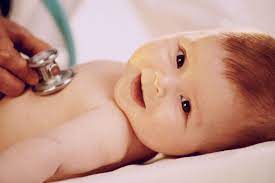SHARE WITH FRIENDS:
Hypothyroidism in children is an endocrine disease in which thyroid hormones are poorly secreted by the thyroid gland or these hormones do not affect the cells. In children, hypothyroidism is manifested by weakness, inhibition, muscle hypotonia, delayed tooth extraction, delayed eruption of gums, growth retardation, and mental developmental delay. In order to detect hypothyroidism in children at an early stage, it is necessary to conduct a screening test for TTG hormone, T4, thyroglobulin, antithyroid antibodies. In addition, ultrasound examination of the thyroid gland (ultrasound) and scintigraphy. Hormone replacement drugs are used to treat hypothyroidism in children.
Hypothyroidism in children is a pathological condition characterized by a deficiency of thyroid hormones. Thyroid hormones include thyroxine (T4), triiodothyronine (T3), and thyrocalcitonin. During the first weeks of pregnancy, the embryo is exposed to thyroid hormones in the mother's body. pregnancyBy 10 to 12 weeks, thyroid gland is formed in the embryo. Thyroid hormones are synthesized in special cells of the thyroid gland - thyrocytes, which capture and retain free iodine from the blood plasma. Thyroid hormones are essential for normal growth in a child’s life. Thyroid hormones control the process of embryogenesis: the formation of bone tissue, the formation and development of the hematopoietic system, the respiratory organs and the immune system, play an important role in brain growth.
Deficiency of thyroid hormones in children leads to serious complications. The younger the child, the more dangerous this pathology. In children, hypothyroidism causes stunted physical and mental development (growth, mental ability), metabolic disorders (protein, fat, carbohydrate, calcium) and thermoregulatory disorders.
Classification of hypothyroidism in children
Hypothyroidism in children can be congenital and acquired. In cases of congenital hypothyroidism, children are born with thyroid hormone deficiency. Based on pediatric endocrinology data, the incidence of congenital hypothyroidism was found in 4 in 5 to 1 infants (twice as common in girls as in boys).
In children, the symptoms of hypothyroidism are transient (transient), subclinical, manifest. There are primary (thyrogenic), secondary (pituitary) and tertiary (hypothalamic) forms depending on the degree of thyroid hormone production disorder.
Causes of hypothyroidism in children
In children, hypothyroidism develops as a result of defects in the hypothalamic-pituitary-thyroid system. In 10-20% of cases, the cause of congenital hypothyroidism may be a gene with a past anomaly inherited from the parents. However, in most cases, congenital hypothyroidism is considered to be accidental.
Primary hypothyroidism occurs mainly in children, in which pathology is observed in the thyroid gland itself. This can be due to congenital defects of the thyroid gland, aplasia, hypoplasia, or dystopia.
Adverse environmental factors (radiation, insufficient iodine in the diet), fetal infection, intrauterine infection, taking certain drugs during pregnancy (thyrostatics, tranquilizers, bromides, lithium salts), autoimmune thyroiditis in the mother , causing endemic goiter.
In 10-15% of cases, hypothyroidism in children is caused by a violation of the synthesis of thyroid hormones and the lack of receptors in the cell that can recognize these hormones.
Congenital pituitary or hypothalamic defects in children with secondary and tertiary hypothyroidism are caused by a genetic defect in the synthesis of the hormone TTG. Acquired hypothyroidism in children occurs as a result of pituitary or thyroid inflammatory disease, tumors, trauma or surgery, endemic iodine deficiency.
Symptoms of hypothyroidism in children
Hypothyroidism can occur in infants with the following symptoms:
-
Late delivery (at 40-42 weeks);
-
The child is overweight (above 3,5-4 kg);
-
Face, eyebrows, tongue (macroglossia), large fingers and toes;
-
Difficulty breathing, low and rough crying.
